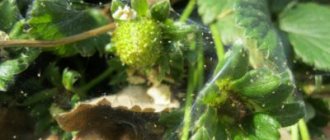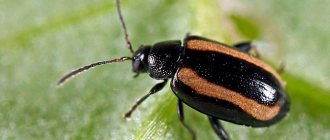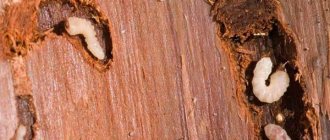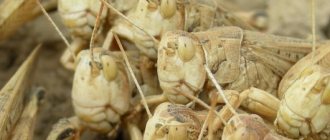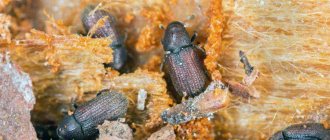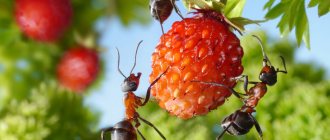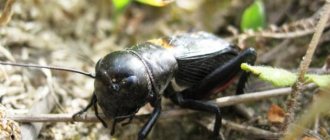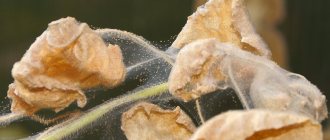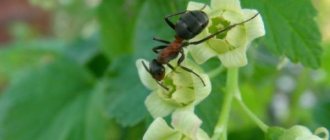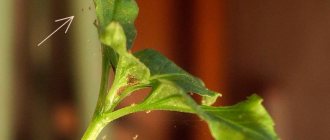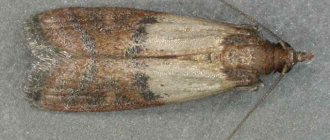The strawberry or strawberry nematode is a microscopic worm that causes enormous damage to plants. Affected plants stop growing actively and wither. In advanced cases, it leads to crop loss. It is difficult to completely get rid of this problem. The best way to combat nematodes can be timely prevention.
Dear readers! For you, we have created communities on social networks in which useful articles and interesting ideas are published several times a day! Subscribe and receive useful content in a convenient format!
Description
The nematode is a very voracious and tenacious pest. Even eggs can remain in the ground for up to 10 years , after which they hatch. It is not easy to detect; the size of this roundworm is from 1 millimeter to 2 centimeters.
What is a nematode - biological description
A nematode or Nematodes is a roundworm belonging to the phylum Protostomes.
The body color is white, sometimes yellowish. Males and females are easily distinguished by body shape. Females are rounder because they carry the eggs within themselves.
The nematode's mouthparts resemble small forceps. With the help of this organ, it is tightly attached to the stem or roots of garden strawberries. After which it actively feeds on the sap of the plant.
Reference! Eggs and adult nematode worms hide in the soil. This is an additional circumstance that makes them difficult to detect and remove.
Types of nematodes
It parasitizes not only strawberries, but also other plants. It could be:
- Golden potato. It affects exclusively plants of the Solanaceae family. The greatest danger is for potatoes. The leaves of the affected plant turn yellow and wither, flowers and tubers do not form;
- Root gall. It parasitizes exclusively on the roots of various vegetables. Each plant species is affected by its own subspecies of nematode. As a result, plants rapidly lose moisture. As a result, their development slows down and productivity decreases;
- Stem. It is most dangerous for plants such as garlic, onions, potatoes and some garden flowers;
- Leafy. These are colorless worms only 0.5 - 1 millimeter long. Lives in the leaves of many plants. Most often found on chrysanthemums, strawberries and tomatoes.
Strawberries or garden strawberries are affected by leaf and stem forms.
Attention! The most common parasite on garden strawberries is the stem nematode.
Risk group
The Kivsyak diet includes root vegetables: carrots, potatoes, radishes, turnips, radishes, beets. As well as apples (carrion), overripe melons, tomatoes and strawberries or raspberries touching the soil. Germinating seeds of cucumbers, tomatoes, zucchini, melons, peas, corn, beans, stems and roots of any seedlings. Chickweeds also eat cucumbers lying on the ground, leaves of cabbage, lettuce, champignons (and other mushrooms), as well as decorative potted crops in closed ground.
Nematode on strawberry
On strawberries it can radically reduce the yield of the plant. The best time for its development is in May - early June. It is at this time that flowering and fruit formation occur, which greatly weakens the plants. The berries become small and ugly and lose their attractive taste.
Peculiarities! Good prevention of nematode damage is varieties that are resistant to the effects of this pest.
What does the affected plant look like?
The nematode is extremely difficult to see with the naked eye. Its presence can be determined by indirect signs:
Swelling on the stem or leaf veins;- Shortening and curvature of petioles;
- Wrinkling and subsequent death of leaves;
- Deformation and reduction of the ovary;
- Specific swellings or galls form on the upper side of the leaves.
The growth of bushes slows down sharply, the plants seem to be “pressed” to the ground. Spreads through infected plants.
Reference! Infected seedlings can be identified upon inspection. In the earthen coma you can see white dots reminiscent of semolina. This is what female nematodes look like, filled with eggs.
What harm can it cause?
Different types of nematodes live in the soil. But they are dangerous only in high concentrations around the plant.
Attaching to the stem and leaves, the worms suck out the juice from them. At the same time, they inject a special chemical into the plant.
It makes the stem or leaves more suitable for the pest.
Another serious danger is the infection of damaged plants with infections.
The nematode becomes a serious threat at concentrations of more than 1,000 worms per square meter. This is possible due to the enormous fertility of females. At one time, they are capable of laying up to 2-000 eggs at a time.
Attention! The nematode additionally serves as a carrier of viral and fungal diseases.
Questions and answers
“Epin – extra” is a unique growth stimulator that not only activates the development of the plant, but also increases immunity, which allows the plant to independently protect itself from diseases and pests, including nematodes.
Question No. 1. How long does it take to get rid of nematodes on strawberries?
Unfortunately, it is impossible to completely eliminate the nematode, but it is possible to reduce the number to a safe amount. Why does prevention and pest control need to be carried out constantly?
Question number 2 . Are nematodes dangerous for humans and pets?
No. The structure of the worms and nutritional needs are designed exclusively for plant juices.
Question number 3 . If strawberries are planted under agrofibre, will it protect against nematodes?
It will not be possible to completely get rid of the worm, but it will be possible to reduce the number and protect the strawberries. Spunbond creates conditions of high humidity that are uncomfortable for worms, which does not contribute to their spread.
Question number 4 . What drug is guaranteed to kill nematodes?
Unfortunately, such a tool has not yet been created. Substances that destroy worms belong to the group of nematicides. The difficulty is that most of them act on adults and damage the eggs. Those, in turn, can wait for favorable conditions for years. That is why it is necessary to carry out preventive measures and ensure that the number of pests does not increase.
Question number 5 . How to determine when purchasing whether there are nematodes on strawberries?
When purchasing seedlings, you need to carefully examine the roots and stems, especially those sold in pots with a lump. There should be no small whitish grains, similar to semolina, this is what females look like, filled with numerous eggs.
Symptoms of damage and reasons for the appearance of nematodes on strawberries
The difficulty of diagnosis lies in the fact that it is impossible to detect a microscopic worm at an early stage. Often external signs of damage resemble a lack of nutrients:
- Bush growth slows down;
- The ovary and fruits are deformed;
- The leaves noticeably become smaller and curl up, and swellings—galls—appear on the upper surface;
- The petioles thicken and shorten.
External signs of the disease appear during flowering and fruiting. In this case, the pest cannot be detected.
You can see the nematode under a microscope; the worm is transparent. Detecting a nematode is very difficult. It not only sticks to the plant, but damages the tissue and causes infection. Most often these are pathogens of fungal diseases. This way the pest infects the strawberries.
Nematodes are present in any soil, but they are dangerous when they are concentrated in one place. This is precisely what can explain the defeat of just a few strawberry bushes, which creates bald spots in the plantings. Complete drying out is rare when the number of nematodes exceeds 1 thousand pieces per 1 square meter. cm.
Worm eggs can remain viable for many years, and under favorable conditions become more active. Particularly intensive growth is observed on moderately moist, acidic soils pH – 5.5 – 5.8, at temperatures + 24 – + 30. Most often, nematodes appear together with infected seedlings.
When purchasing strawberry seedlings, it is important not only to evaluate the appearance of the bush, but also to carefully examine the roots.
Even if no external signs of damage are found, before planting you need to take measures against the spread of the pest. Carefully inspect the roots. There should be no suspicious spots or inclusions on them. For prevention, pour hot water over the roots.
What are the signs to identify a nematode?
The main signs of the nematode are depressed, squat plants and stunted growth. Leaves, peduncles, petioles, deformed mustaches,
- The leaves wrinkle, curl, may become smaller, become leathery (rough and similar to corrugated paper), and look as if they are pulled towards the central vein. The central vein of the leaf has swelling, it seems that the leaf is broken in several places.
- The petioles are shortened, thick, twisted, acquire an atypical reddish color, and the pubescence disappears.
- Stems thicken and branch heavily
- The buds, flowers and ovaries take on an ugly shape, sometimes forming like a miniature green head of cauliflower.
- Pale green growths form on the mustache, the mustache is thickened and shortened.
- Berries become small and ugly
- The tissues of leaves, petioles, peduncles and tendrils become loose.
The signs of mite and nematode infestation are very similar. The main difference: with a nematode, dark green leathery spots appear on the leaf, and with a mite, the leaf becomes lighter.
How to fight the disease
Once a nematode appears, it will be quite difficult to get rid of it. The removal process from the site may take longer than 3 months. The following methods can be used for this:
- Agronomic (these include deep digging of the earth, soil optimization and changing the planting site);
- Mechanical (treatment of the root system of plants with hot water);
- Chemical (nematicide treatment);
- Biological (planting plants next to the bed, the proximity of which is not tolerated by nematodes).
More information about the fight against nematodes can be found in the video below:
Severely affected bushes should be destroyed immediately. This will prevent infection of healthy plants. The best effect is achieved by a combination of these measures.
Reference! It is impossible to completely get rid of nematodes from an area. But you can reduce its amount to an acceptable amount.
Method of treatment with folk remedies
Proven folk remedies include hot water treatment. The method is effective at the initial stage of root infection. Thus, it is possible to “cure” seedlings if female nematodes are found in the root coma of the soil. For this:
- Dig up a mature bush. If we are talking about seedlings, they are carefully removed from the pots;
- Thoroughly wash off the soil and nematodes from the roots. This water should not be used for watering other plants or for composting;
- The roots of the plant are immersed in a container of water. A water temperature of 45 - 50 C will ensure the death of not only adult worms, but also eggs. Do not use hotter water so as not to damage the bush. Keep for 5 to 20 minutes.
After this, the bush is carefully transplanted to a new place and watered abundantly. Spraying with decoctions of plants that are poisonous to nematodes also has a good effect. It can be:
- Marigolds (1 kilogram of inflorescences per 10 liters of water, spray the bushes with a filtered solution;
- Calendula (1 spoon of flowers per 1 liter of water);
- Large nasturtium (300 grams of plants per 1 liter of water);
- Onion (30 grams of dry plant per 5 liters of water).
Unlike chemical nematodocytes, spraying with plant products can be done during flowering and ovary formation.
How to treat with chemicals
The most popular nematicides include:
Mercaptophos;- Ruskamin;
- Lindan;
- Heterophos;
- Phosphamtide.
The solution is prepared and used according to the instructions included with the drug. Treatment is usually carried out before flowering begins.
It is recommended to carry out excavation work after treatment only after 45 days.
Carefully! Nematicides are highly toxic. Work must be carried out using personal protective equipment. These include a respirator, gloves and thick clothing.
Strawberry varieties resistant to nematodes
If the site already has such a problem, it is worth paying special attention to prevention.
One of the most effective measures is the use of pest-resistant varieties. The most popular of them:
- Festival;
- Saxon;
- Granddaughter;
- Pearl mussel;
- Rocket.
At the same time, they have strong immunity to viral and fungal infections.
Peculiarities! The use of resistant varieties is the prevention of the most dangerous fungal diseases of garden strawberries.
Folk remedies
If the situation is not advanced or you simply don’t want to use chemicals, there is an alternative option than treating the berry plantation. Use folk remedies that are not so aggressive.
- Hot water
Since the nematode settles mainly on rhizomes and is afraid of elevated temperatures, it is recommended to spill the infected bed with hot water (no more than 55°C).
- Flower infusions
The juice of some plants acts as a poison on roundworms. Based on them, you can prepare infusions and pour them over strawberries. Usually marigolds or marigolds are used. Take 1 kg of flowers, crush them, add 5 liters of warm water, infuse them covered in a warm place for 2 days and strain. Use every other day.
- Onion infusion
Soak 200 g of leeks in 5 liters of warm water for a day. Strain. Use for watering and irrigation once a week.
- Ammonia
Rub a piece of laundry soap (72%), pour 1 liter of hot water into it, and beat thoroughly until a thick foam forms. Pour a bottle of 10% ammonia into another container with 1 liter of water at room temperature. Mix. Pour both resulting solutions into a bucket with 8 liters of water prepared in advance. After thoroughly mixing, without leaving for later, pour over the strawberries. Judging by the reviews, the product helps well against root nematodes.
Folk remedies are effective mainly in the early stages of infection or for preventive purposes.
Prevention measures
Measures to prevent nematode infection include:
- High-quality planting material. Most often, infection occurs through infected seedlings. It is worth purchasing it in nurseries or trusted stores;
- Pre-planting treatment of plant roots with drugs such as Paradrion or Fosdrin;
- Adding compost to the soil. The fungi contained in it destroy nematodes;
- Regular transfer to another place. It needs to be done every 4 – 5 years.
Planting plants with an active scent next to the strawberry beds helps.:
Marigolds (example in the photo on the right);- Nasturtium;
- Medicinal calendula;
- Rudbeckia pilosa; Coreopsis Drumond;
- Gaypardia is beautiful.
They can be planted around the perimeter of strawberry beds, providing reliable protection.
Pest danger
When the strawberry nematode begins to infect the beds, the plants wither and wither. If measures are not taken in a timely manner, the harvest may be lost. Parasites carry many phytopathogenic microorganisms, which easily penetrate plant tissue through affected areas, which are eaten away by nematodes. This is fraught with infectious contamination, disease or loss of harvest.
Nematodes, when they land on strawberries, feed on them, grow stronger and begin to multiply intensively. Colonies are not easy to defeat, so it is important to notice the appearance of worms at the initial stage, before they create entire colonies under each leaf.
Mistakes when fighting strawberry nematode
To reduce the risk of nematodes, it is important not to repeat common mistakes:
- Use of insecticides. They are effective against insects, but are completely useless against nematodes;
- Throwing affected plants into compost. Nematode eggs have excellent vitality for up to 10 years.
It is dangerous to ignore lightly infected bushes. At this stage, the affected plants can be cured in time. Even 1–2 bad-looking bushes should alert you.
The nematode or roundworm is one of the most dangerous pests of garden strawberries. These microscopic worms infect the leaves, berries, roots and stems of the plant. Getting rid of the problem is difficult, since eggs and adults are quite tenacious. Spreads through contaminated planting material or soil.
Causes
The nematode starts under certain conditions, which are the reasons:
- 5.5–5.8 pH is the permissible acidity of the soil in which the worm starts; under other conditions there will be no infection;
- air temperature +25...+30 C , if it is colder or warmer, the larvae do not survive;
- decreased plant immunity due to lack of nutrition, drought or, conversely, excessive moisture.
The main reason for the appearance of parasites is the use of infected seedlings.
Using traps against nooses
Construction of artificial shelters from available materials: pieces of boards or old roofing felt, wet rags, etc. under which nods gather, followed by inspection of shelters and destruction of pests under them. You can also use food bait - spread pieces of carrots, potatoes, apples around the area, followed by collecting and destroying the noose. You can dig trapping grooves up to 10 cm deep and 6–7 cm wide, at the bottom of which mayonnaise jars are dug at a distance of 2–3 m. When crawling along the surface, the nooses fall into the groove, crawl along the bottom and end up in the jars. In the fall, you can dig holes 30 x 30 cm in size and 30 - 40 cm deep, put leaves, slices of potatoes, carrots and vegetable waste in them, sprinkle with a 5 - 10 cm layer of earth. Mark the holes with branches so that they can be easily found. With the onset of frost, take out the contents of the pits and burn them together with the nodules on a fire, or simply scatter them around the area - all the pests gathered for the winter will die. Repelling squids with superphosphate, ash, soap-kerosene emulsion, as well as using molluscicides (Thunderstorm, Slug Eater) against them is ineffective, since the surface of the squid's body is protected by a thick layer of chitin. These products can cause minor harm only to recently molted larvae, whose chitinous layer has not yet reached the required size.
Strawberry (garden strawberry) spoiled by kiwi
